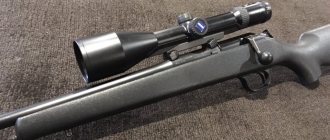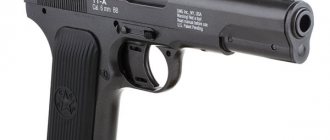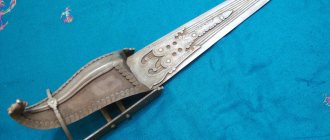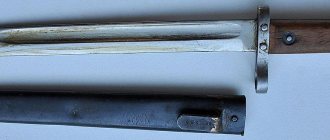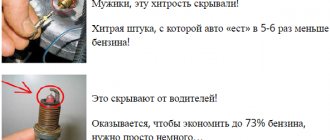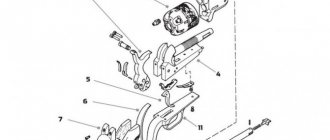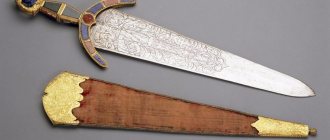Dirk "SS" (Schutzstaffel) in good collectible condition with RZM marking on the blade. Complete with original double hanger. There is a mark on the suspension carabiner and pressed SS markings can be seen on the leather. The blade is in original factory polish. The scabbard is in its original black paint. Coated zinc guards. The SS runes and the eagle have not been restored. On the blade of the dagger there is a clear motto of the SS security detachments “Meine Ehre heisst Treue” (“My honor is called loyalty”) - deep matte etching. The dirk is shown disassembled: guards with markings, letter B. Shank and guards patinated inside. We have unscrewed the dagger for the first time since its manufacture, since the forties of the last century...
The dagger is accompanied by an expert opinion from the Ministry of Culture
From January 25, 1935, persons dismissed from the ranks of the SS were obliged to hand over their daggers, despite the fact that they bought them back with their own money. If it was a question of retirement, then the dagger was allowed to be retained, and the right to own it was certified by a certificate. THE SAME DAGGER IS PRESENTED IN THE WITMAN COLLECTION SS daggers were produced only by leading manufacturers of edged weapons: Boeker & Co, Carl Eickhorn, Gottlieb Hammesfahr, Richard Herder, Jacobs & Co, Robert Klaas, Ernst Pack & Soehne, C. Bertram Reinhardt.
SS elite unit of the Third Reich
A small organizational unit was created in 1925 to provide personal protection and security for Adolf Hitler. The formation did not have much influence until 1929.
With the arrival of Heinrich Himmler, the SS began to differ:
- power and independence;
- control over the state police;
- ruthless and principled decisions.
At first the SS was part of the SA units. Later the unit became autonomous. There were several conditions for admission:
- age not younger than 21 years;
- completion of a probationary period of at least 18 months;
- testing of beliefs, loyalty, unquestioningness;
- good physical fitness.
The SS is considered the most brutal and hated formation of the Third Reich.
Knives Hitler Youth (HJ)
The youth organization became famous for its aggressive protests, and during the war years it attracted children and teenagers to National Socialist ideology.
Characteristics of knives of Hitler Youth participants:
| Length | Width |
| In centimeters | |
| 24,5 | 2,5 |
Daggers were produced in a standard form and in honor of special events - parades, Olympics, party congresses. Weapon Features:
- blade with one-sided sharpening;
- textured handle with nickel-plated figured end;
- in the center of the handle is a swastika on a red and white diamond.
The simple black scabbard was made of nickel.
SS dagger - uniform service edged weapon
The shape is similar to the ancient Roman sword, the image of which is on the column of Emperor Trajan in Rome. The design was developed in Munich, although the center of production of bladed weapons is the city of Solingen.
It was put into service in 1933. The device was awarded upon admission to the Schutzstaffel (SS) security detachment. In case of loss, it was necessary to pay 8.40 Reichsmarks.
The first examples are analogues of standard SA daggers, released in 1933. The difference is:
- black handle;
- sheath corresponding to the style of uniform.
The emblem consisted of two stylized letters “S” in the form of lightning. They decorated the upper part of the black handle. The SS blade was engraved with the motto “Meine Ehre heist Treue,” which translated means “My honor is called loyalty.”
The first samples consisted of metal parts finished with cupronickel. The scabbard was based on oxidized iron. Later replaced with nickel-plated iron. At the base of the pommel of the handle with a guard element the following was used:
- zinc;
- aluminum.
SS weapons.
The eagles on the handles held the swastika in their claws. They were marked with:
- nickel;
- zinc;
- aluminum.
Patent marks on German daggers
Many German bladed weapons contain the abbreviation Ges. Gesh. This is a shortened form of Geserzlich Gesehutzt, which literally translates to “protected by law.” This mark was affixed either directly on the hilt of the dagger itself, or on the blade under the hilt, where the manufacturer’s mark was usually located. These innovations may lie in the method of manufacturing the product, and in the special shape of individual parts of the dagger, etc. This mark indicates that the company received a patent for the production of this type of product. As in modern manufacturing, the manufacturer cannot deviate from the standards introduced by the company or organization that owns the patent. The copyright holder company can put DRP symbols on the blade. which stands for Deutsches Reichs Patent indicate its rights and that the design of this product cannot be repeated without prior agreement with another manufacturer. Mottos on blades All members of one or another organization of the Third Reich were required to wear the official mottos of their formations, which, as a rule, were etched on the blades of their daggers. The official and most common mottos were: SA, NSKK - “Alles fur Deutschland” (“All for Germany”); SS - “Meine Ehre heisst Treue” (“My honor is called loyalty”); MREA - “Mehr Sein als Scheinen” (“Be better than you are”}; Labor Corps - “Arbeit adelt” (“Work ennobles”); HJ - “Blut und Ehre” (“Blood and Honor”)
How to distinguish a fake from the original?
Despite the huge variety of German edged weapons from the period of the Third Reich, only a small fraction of well-preserved specimens have reached us. It’s all the more offensive to buy another fake for a very large sum. How to distinguish a real dagger from a fake? There is no short answer to this seemingly simple question. This topic has been the subject of serious research published in special publications. For example, the book by R. McFarlane, “Bluebook of Identification of Reproduction Nazi Edged Weapons,” published in July 1969 in England, is of interest. You should also pay attention to the section on this topic in the book “Edged Weaponry of the Third Reich” by Major Jack Angolia. We will not list the specific features reflected in this type of research. You can find them in the sources listed above. We provide only key recommendations that will help researchers and collectors make the right decision when purchasing or inspecting the next sample of edged weapons. There can be nothing more valuable than your own experience gained through years of research and work. However, there are some basic signs of fakes that are understandable even to a layman. In the future, we will refer to them as a kind of “red flags” that indicate a high degree of probability of acquiring a fake. Regardless of how many of these “flags” a collector finds—one or several—it is necessary to refrain from purchasing the sample in question. Although even in this case, you can make a mistake and mistake the real item for a fake. Still, when it comes to a collection, it is better to be more vigilant and follow the saying “Measure twice, cut once.” Such “red flags” are the following signs: 1. Too “fresh” appearance. A huge number of weapons on the market today look very new. More than 60 years have passed since the war, and this weapon looks as if it was made two or three weeks ago. When inspecting the weapon, pay attention to the mounting screws. You should be interested in their condition: shine, surface condition (presence of dirt or signs of corrosion). It is also necessary to pay attention to the condition of the leather that covers the sheath or handle. If it looks the same as the trouser belt you bought the other day, you should be careful. Take a flashlight and carefully examine the entrance hole on the sheath. If the surface inside the sheath also looks new, then it probably is. Unfortunately, there are now many ways to give a touch of “time” to any item, so abrasions and other manifestations of the long life of a given sample do not yet indicate its authenticity. 2. Size mismatch. It is known that the Germans have always been very careful in controlling the quality of their products. The meticulous approach to quality assessment in the production of cars, cameras and other high-tech products cannot but arouse admiration throughout the world. The fact that modern copies of bladed weapons produced in the USA, Spain, England and other countries cannot compare with the original weapons of the Third Reich once again proves this truism.
Basic parameters of the SS dagger
Product characteristics:
- blade length – 22 – 23 cm;
- blade width – 34 – 37 cm;
- thickness at the heel – 5.5 mm;
- length in sheath – 36 – 37.5 cm;
- length without sheath – 34.5 – 35 cm;
- handle length – 11 cm;
- handle width – 35 mm;
- handle thickness – 21 mm;
- the blade is double-edged.
The handle is mostly wooden. The blade had a massive guard. The hilt adjacent to the handle was cut out. On one side there is an engraving, on the other - the manufacturer's mark and the date of issue.
In 1934, SS leader Kurt Withier issued a decree banning the sale. At the same time, guns from other units were sold freely.
Since 1935, markings appeared on the hilt indicating special centers for issuing guns in the following cities:
- Munich;
- Dresden;
- Berlin.
The devices were state property. Models owned by senior staff had a mark on the back of the hilt. For junior officers - on the side parts of the guard.
In case of dismissal, all signs were destroyed. Retired officers could leave the products, but only if they had official documents from management. The production of devices ended in 1942.
Reconstruction of a Third Reich dagger.
Manufacturers
Manufacturer Year Territoriality Supervisory authority Abbreviation District Brand, logo Aesculap Werke (Jetter & Scheerer) 1867 Tuttlingen - S/245, dnw, J.Sch - Backhaus FW, Stahlwarenfabrik Friedrich Wilhelm 1827 Solingen RZM M7/44 - BO, He, Ns Bahrl Julius Jr. — Solingen — — Wf Balke Richard & Söhne 1919 Solingen — — Wf Barthelemes Fritz (BAVARIA) — Muggendorf — — Fr Becker Eduard (KOLUMBUSWERK) 1878 Solingen — — He, Sw Becker Gebrüder, Stahlwarenfabrik 1921 Solingen — — He, Ns, Wf, No, Om Bell Gebrüder, Stahlwarenfabrik 1876 Solingen-Gräfrath RZM M7/94 - He, BO Bender Carl 1904 Solingen - - Ha Berns Gebrüder (OTTER WERK) 1840 Solingen - - Ho, Wm Berns Hugo (HUBEO) 1903 Solingen-Ohligs - - P, Sa, Wf Bertram C. Reinhard & Sohn 1864 Solingen RZM M7/79 — — Bickel August (AB) 1884 Steinbach-Hallenberg — — BO, Fr, He, Mi, S Karl Böcker 1918 Solingen RZM M7/45 — P, Wf Bodenstein Julius, Messerfabrik - Steinbach Kreis Meiningen, Thüringen - - BO, Fr Böhme Nachf. Gebrüder, Messerfabrik - Brotterode - - Sa, Th Böker Heinrich & Co. (BAUMWERK) 1869 Solingen RZM M7/75 — — Bonsmann E. (DREIANKERWERK) 1866 Solingen — — Nm, Om, P Böntgen & Sabin, BONSAWERK, Stahlwaren-Fabrik 1876 Solingen — — No, Nrh, Wf Born Gebrüder (GB) — Solingen RZM M7/82 - Wf Braun Adolf (Alcoso Solingen) - Berlin - - - Brenger Justus & Co. (JUSTINUSWERK) 1886 Solingen RZM M7/16 - BO, He Brosy Steinbergm F. von Brosy 1872 Solingen-Gräfrath - - Ha, Ho, OST, Wm Bruckmann Ernst (MANN) 1901 Solingen-Ohligs - - Ho, Wm Büchel Rudolf (RBS ) 1923 Solingen-Merscheid - - He, Ns Karl Burgsmüller - Berlin-Charlottenburg 5. - NPEA Schulen - Busch Ernst - Solingen - - He Gebr. Christians (Christianswerk) 1824 Solingen-Hasten RZM M7/1RZM 1202/38 - Nrh Cleff Ewald, Waffenfabrik 1867 Solingen RZM M7/93 - Ho, Nrh, Wm Clemen & Jung, Waffen- und Metallwarenfabrik 1860 Solingen - CqhS/241 Ha, Ho , Nrh Alexander Coppel "ALCOSO" 1821 Solingen - fnj, awsS/173 - Curdts EH Otto (Nachfolger), CURNA GmbH, Stahlwarenfabrik 1851 Solingen - - Ho Dick Friedrich 1778 Esslingen - - He, Sw, Wm Dirlam & Söhne 1856 Solingen - - Nrh Dirlam Ernst (HOFFNUNGSWERK) 1854 Solingen - - Wf Dittert JE & Co. — Neustadt, Sachsen — — Sa Albert Dörschel, Gesenkschmiederei 1878 Solingen — — Nrh, Wm Drees Richard & Sohn 1911 Solingen RZM M7/96 — Nrh, S Paul Ebel, Stahlwarenfabrik — Solingen RZM M7/47 — Om, Wf Eickelnberg & Mack GmbH — Solingen RZM M7/90 — P Carl Eickhorn, Stahlwarenfabrik 1865 Solingen RZM M7/66RZM 941/## CofS/172 B, BO, Fr, Ha, He, Ho, No, Ns, Nrh, Om, OST, Sa, Sw , Wf, Wm Eppenstein C. & Söhne - Solingen - - Ho, Nm, Nrh, Wm Erbe HA - Solingen RZM M7/69 - - Evertz Arthur 1925 Solingen RZM M7/85 - - Felbeck & Picard 1922 Solingen RZM M7/110 - — Felix Gustav (GLORIAWERK) 1843 Solingen RZM M7/28 — Nm, Wm Frenzel Franz (FRENIXWERK) 1870 Nixdorf in Böhmen (Tschechien) RZM M7/116 — — Geigis Friedrich 1919 Solingen-Foche RZM M7/64 — Ns Gembruch Eduard 1871 So lingen -Gräfrath RZM M7/8 - B, Ho Gerling Ernst 1902 Solingen-Ohligs - - - Gierling Emil - Solingen RZM M7/46 - P, Wf, Wm Giersch Robert - Solingen - - Wm Giesen und Forsthoff 1920 Solingen - - He, Ns , S, Wf Gräfrath Gebrüder (GRÄWISO) 1878 Solingen-Widdert RZM M7/30 - He, Nm, Wm Grah Carl - Solingen-Ohligs - - Om, Wf Grah Ernst 1897 Solingen-Wald - - Nm, Wm Grah Gustav Reinhold - Solingen -Foche — — Wf, Om Groten Ludwig 1919 Solingen — — Ns, Wf Haas Carl 1910 Solingen-Wald — — Ha Haastert Richard & Büll — Solingen-Wald — — B, Ha, He, Sa Hack Josef, Hackwerke GmbH 1875 Steyr, Österreich RZM M7/103 — — Haco-Werk, HACO Transport GmbH — Berlin — &
Types of SS daggers
The first models were distinguished by high-quality manufacturing. The base was cupronickel. Since 1935, the butt plate and hilt were replaced with aluminum ones. The scabbard was painted.
In June 1934, as a result of the active liquidation of Ernst Rehm, 200 attack aircraft distinguished themselves. They were awarded rare models bearing the personal signature of Heinrich Himmler - “In herzlicher Freundschaft H.Himmler”, which meant “As a sign of cordial friendship of Heinrich Himmler.
They are numbered at the bottom of the hilt. Only 200 pieces were produced. This was a special thank you from the famous leader.
The 1933 samples were distinguished by 3 types of suspensions:
- standard – in the form of a carabiner with a leather strap with a round silver clasp;
- with a holder - outwardly similar to the previous type, but the leather mount had a strap and a metal button that fixes the handle in an almost motionless state;
- version consisting of three parts. It was put on a scabbard. It was equipped with a carbine on the reverse side.
The scabbard was:
- copper;
- tin.
For officers, sheaths were made with gold or silver elements. Special screws were used for fastening. They had semicircular heads. The pendant was a short leather strap with a metal clasp and a flat carabiner.
SS dagger 1933.
Postal Guard Dagger
Postal guard knife.
They also produced a model for the SS postal guard. Postal workers were classified as government employees. Later they were included in the formation and armed.
The handle was wooden. Painted with black paint. The guard was an eagle's head. In the middle of the cross there was a medallion. The role of the suspension was performed by a silver metal chain.
The upper part had 9 ring-shaped links, the lower part – 12. The lanyard had weaves of orange or red threads. The silver-colored lanyard, 42 cm long, was worn by selected officers.
SS honor dagger model 1936
This bayonet - knife is almost an exact copy of the 1933 specimens. The difference lies in the modified scabbard suspension system. They relied:
- officers who entered service after November 9, 1935;
- soldiers who joined the unit for at least three years before February 1, 1936.
The pendants were designed by Karl Diebitsch. The pendants were in the form of flat metal chains, which consisted of placed skulls with emblems. These were SS sigruns - lightning. They symbolized the victory of good over evil.
The upper parts of the chains were equipped with two plates, and the lower ones with four. There were metal inserts in the center. They were decorated with stylized relief swastikas.
The carbines had ancient German armor ornaments in the form of clover leaves. The chains were plated with nickel. The base is Damascus steel. It was forged by hand and the motto was minted in gold. There were no marks on particularly important models. These were intended:
- Unterfuhrers;
- to the Fuhrers of Schutzstaffel.
German dagger model 1936.
RZM sign
All daggers and knives produced specifically for the needs of organizations such as SA. SS, NSKK and Hitler Youth were subject to mandatory quality control, which was certified by the RZM (Reichszeugmeisterei) mark. This is a kind of analogue of the quality control mark at our modern enterprises. The Nazi control service - the Reichszeugmeisterei der NSDAP (Reichszeugmeisterei der NSDAP) was formed in 1934 to strictly supervise the production, pricing and quality of products produced for the needs of the party. Any company engaged in the manufacture of uniforms, awards or insignia, as well as other similar products, was required to obtain official permission from the RZM and the corresponding control number. As an example, we give the decoding of one of these numbers: RZM M7/66/42 RZM; (Nazi Control Service (Reichszengmeistrei)); M: metal product: 7: type of product of the manufacturer (in our case, edged weapons); 66: code name of the manufacturer (in this case Karl Eichhorn); 42: year of manufacture. Unfortunately, today the complete list of manufacturers and suppliers of bladed weapons (Industrie und Handeishammer zu Zolingen) has been lost. This happened as a result of massive bombing of the industrial areas of Solingen by Allied aircraft. Therefore, modern collectors find individual copies containing a control number that cannot be identified precisely due to lost records and other adjustments made by the passage of time. Peculiarities of marking by various organizations of Nazi Germany: some organizations, for example, the Nazi party school, the postal service and the German Red Cross, affixed their initials directly to the hilt of the weapon. In the case of the DRK, the corresponding inscription was applied on the back of the dagger in the place where, on the front side, there was an image of a German eagle clutching the Red Cross emblem in its talons. In contrast to this method of marking, organizations such as NSFK and DLV placed their emblem on the end of the dagger sheath. In rare cases, you can see two stamped emblems of these organizations on the same scabbard. The reasons for this should be sought in their history. First, as mentioned earlier, a community of DLV pilots was created. It then came under the control of the Nazi Party and was reorganized as the NSFK.
Serial numbers were also used to record the number of military personnel in a particular organization. Typical examples are the daggers and cutlasses of the German Postal Service, the Technical Corps (TENO), party schools, as well as the bayonet-knives of police units. And by the numbers stamped on the daggers of the SS, SA and the National Socialist Corps, it was possible to find out all the ins and outs of its owner. Along with these numbers, the manufacturers themselves applied special numbers that facilitate the process of releasing the final product during assembly production. If the components of a certain type of dagger were not manufactured at one enterprise, but were dispersed in different places in the city, then they were all marked with one code so that the final assembler knew which product they belonged to. This is clearly seen in the example of daggers for diplomatic workers. Here, each part of the dagger is marked with a special two-digit code. Group affiliation As mentioned earlier, the daggers of the SA, National Socialist Corps and SS units were marked with special symbols or numbers that determined membership in a particular group (mainly by their geographical location). Using this abbreviation, it was possible to find out which regional organization the owner of the dagger belonged to, as well as the division and army unit. The SS daggers were marked with the army group code in Roman numerals. On the Gitperjugend knife there was a number directly above the RZM control sign, which indicated the territorial affiliation of the organization of which its owner was a member.
Links
- Website Symbols and rituals of the Waffen-SS
- German phrases
- SS
Wikimedia Foundation. 2010.
Useful
See what “Meine Ehre heißt Treue” is in other dictionaries:
Meine Ehre heißt Treue - “Meine Ehre heißt Treue” war der Wahlspruch der Schutzstaffel (SS). Seit 1932 wurde der Wahlspruch in die Koppelschlösser der Allgemeinen SS und ihrer Nebenverbände (SS Verfügungstruppe, SS Toten … Deutsch Wikipedia
Unsere Ehre heißt Treue - “Meine Ehre heißt Treue” war der Wahlspruch der Schutzstaffel (SS). Inhaltsverzeichnis 1 Herkunft 2 Bedeutung 3 Verwendung 4 Rechtliches 5 Einzelnachweise … Deutsch Wikipedia
Story
Appearance
The expression has existed in German since at least the beginning of the 20th century and meant that a servant's honor lies in loyalty to his master. Thus, in 1903, Felix Dahn wrote:
According to one of them, this phrase was in a letter from Hitler to the head of the Berlin SS branch, Kurt Daluga. Hitler gave Dalyuga a letter expressing gratitude. In this letter of gratitude, Hitler also had a sentence:
| ...SS man, your honor is called loyalty! |
The head of the SS, Heinrich Himmler, introduced this sentence as the motto of the SS based on this letter.
Meaning of the motto
“I swear to you, Adolf Hitler, as the Fuhrer and Chancellor of the Reich, to be faithful and courageous. I solemnly promise to be loyal to you and the leaders you have appointed until my death, so help me God.”
“Ich schwöre dir, Adolf Hitler, als Führer und als Kanzler des Reiches, Treue und Tapferkeit. Ich gelobe dir und den von dir bestimmten Vorgesetzten Gehorsam bis in den Tod, so wahr mir Gott helfe.”
How this loyalty was to be expressed depended not on the ethical ideal, but on the personality and desire of Hitler. “Loyalty” was unquestioning obedience within the SS ideology.
The concepts of “loyalty” and “honor” have undergone a dramatic change from their traditional meaning. As a result, the concept of “honor” lost its traditional moral content. The eternal honor of a soldier who, based on his own moral principles, could refuse to participate in a war crime, no longer existed. This was necessary in order to obtain unconditional obedience when given commands that violated laws and went beyond the moral boundaries of normal soldier behavior.

